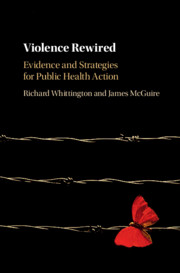Book contents
- Violence Rewired
- Violence Rewired
- Copyright page
- Epigraph
- Contents
- Figures
- Tables
- Boxes
- Foreword
- Acknowledgements
- Introduction and Overview
- Part I Origins
- Part II Solutions
- 6 Advancing a Global Public Health Response to Violence
- 7 Risk Assessment
- 8 Pharmaceutical Interventions
- 9 Psychosocial Interventions
- 10 Changing Structures
- Rewiring Our Expectations
- Appendix Major UN Initiatives to Address Violence, 1986–2018
- References
- Index
7 - Risk Assessment
Can Violence Be Predicted?
from Part II - Solutions
Published online by Cambridge University Press: 13 March 2020
- Violence Rewired
- Violence Rewired
- Copyright page
- Epigraph
- Contents
- Figures
- Tables
- Boxes
- Foreword
- Acknowledgements
- Introduction and Overview
- Part I Origins
- Part II Solutions
- 6 Advancing a Global Public Health Response to Violence
- 7 Risk Assessment
- 8 Pharmaceutical Interventions
- 9 Psychosocial Interventions
- 10 Changing Structures
- Rewiring Our Expectations
- Appendix Major UN Initiatives to Address Violence, 1986–2018
- References
- Index
Summary
Prevention of violence before it occurs is the cornerstone of a public health approach, but whole-population strategies delivered through the media and education channels address only part of the problem. Effective tertiary prevention of further violence by those who have already perpetrated it requires careful appraisal, as far as is possible, of the likelihood of its recurrence. Effective secondary prevention with those deemed at higher risk than the general population requires successful identification of those who would benefit from targeted interventions. Each of these in turn relies upon the development of effective risk assessment tools, and this aspect of violence prevention has developed rapidly over the past three decades. The recognition of separate factors that are associated with the occurrence of violent acts, such as those we surveyed in Chapter 4, has opened up the possibility of using that information to predict when such acts might occur. Attempts to do this usually focus on whether there may be some individuals who are more likely than others to behave this way. As a result of some combination of temperament, upbringing, attitudes, personality traits, poor self-control or other influences, are there people who are likely to resort to violence more readily than most others? More worryingly, are there some who might do so repeatedly, or might commit very serious forms of it? If we can identify them, we might be able to go a stage further and forecast when or against whom they are about to commit an assault.
Information
- Type
- Chapter
- Information
- Violence RewiredEvidence and Strategies for Public Health Action, pp. 165 - 185Publisher: Cambridge University PressPrint publication year: 2020
